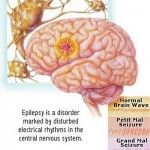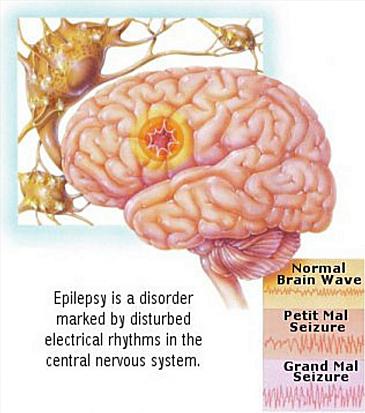Laboratory Studies
When evaluating a child for staring spells, laboratory tests for metabolic abnormalities or toxic or drug ingestion (especially in older children) may be indicated. If a clear history of the episodic nature of the attacks is obtained, then the EEG can be diagnostic and laboratory tests may not be necessary.
When evaluating a child with a developmental delay, or if the EEG reveals atypical absences, then a full work-up for the underlying cause of a symptomatic generalized epilepsy is indicated.
Pharmacologic Treatment
 Treatment for absence seizures involves antiepileptic drugs (AEDs). Once the proper diagnosis (ie, of the specific epilepsy syndrome) is made, the likelihood of other, coexistent seizure types in the patient, such as myoclonic or tonic-clonic seizures, should be considered and an appropriate medication selected. Since altered awareness occurs with even brief bursts of spike-wave paroxysms on EEG, treatment should be titrated to suppressing all epileptiform activity.
Treatment for absence seizures involves antiepileptic drugs (AEDs). Once the proper diagnosis (ie, of the specific epilepsy syndrome) is made, the likelihood of other, coexistent seizure types in the patient, such as myoclonic or tonic-clonic seizures, should be considered and an appropriate medication selected. Since altered awareness occurs with even brief bursts of spike-wave paroxysms on EEG, treatment should be titrated to suppressing all epileptiform activity.
The decision to start antiepileptic medication must be made with great care. Most AEDs are relatively toxic and can have sedative and cognitive side effects. Children with absence seizures may need to be on medication for many years, and in some cases, for life. EEG can usually confirm the diagnosis, and the presence of spontaneous seizures can be documented on routine EEG or with longer recordings (ie, 24-hour ambulatory EEG or EEG video monitoring).
Only 2 first-line AEDs have approval from the US Food and Drug Administration (FDA) to be indicated for absence seizures: ethosuximide (Zarontin) and valproic acid (Depakene, Depacon). Ethosuximide has efficacy for absence seizures only and valproic acid has efficacy for absence, generalized tonic-clonic, and myoclonic seizures.
Ethosuximide (Zarontin) is effective only against absence seizures.
Valproic acid (Depakene, Depacon, Depakote, Depakote ER) is considered a broad-spectrum AED, because it is effective against absence, myoclonic, tonic-clonic, and partial seizures.
A study showed that ethosuximide and valproic acid were more effective than lamotrigine in the treatment of childhood absence epilepsy, and that ethosuximide had fewer adverse attentional side effects.
Symptomatic generalized epilepsies are often refractory to first-line AEDs. Lamotrigine (Lamictal), topiramate (Topamax), and felbamate (Felbatol) are approved by the FDA as adjunctive therapy for the generalized seizures of Lennox-Gastaut syndrome in adult and pediatric patients (>2 y). Clonazepam (Klonopin) and the ketogenic or medium-chain triglyceride diet have been attempted to reduce seizure frequency. However, these adjunctive therapies have limited efficacy.
Of the newer AEDs, lamotrigine, topiramate, and levetiracetam have been shown to have efficacy against seizures in idiopathic generalized epilepsy and have received FDA approval to be indicated for adjunctive therapy of generalized tonic-clonic seizures in idiopathic generalized epilepsy in children aged 2 years and older (for lamotrigine and topiramate) and in children aged 6 years and older (for levetiracetam).
Lamotrigine and topiramate are also approved as adjunctive therapy in Lennox-Gastaut syndrome in children aged 2 years and older. Rufinamide (Banzel) has been shown effective against typical and atypical absence seizures as well as other seizures in Lennox-Gastaut syndrome and is approved as adjunct therapy in children older than 4 years.
Topiramate has also received FDA approval as initial monotherapy for generalized tonic-clonic seizures in children aged 10 years and older with idiopathic generalized epilepsy. Studies have shown these medications to have antiabsence efficacy, but the data are incomplete.
Some AEDs can aggravate seizures, especially in cryptogenic or symptomatic generalized epilepsies. Treatment with carbamazepine (Tegretol, Tegretol XR, Carbatrol) and oxcarbazepine (Trileptal) has been associated with the exacerbation of absence seizures. Gabapentin (Neurontin) is ineffective against absence seizures, and tiagabine (Gabitril) and vigabatrin (Sabril) have been associated with the exacerbation of absence or myoclonic seizures in some patients.
Conception and pregnancy considerations
Women of childbearing age who are not using adequate birth control should not be treated with valproic acid, if equally effective alternatives are available for them.
If a woman taking valproic acid wishes to become pregnant, treatment may be crossed over to ethosuximide if only absence seizures are present, and she may be given folic acid 1-5 mg/d before conception. After the first trimester, treatment may be switched back to valproic acid.
Women with generalized tonic-clonic seizures may be crossed over to lamotrigine, and given folic acid 1-5 mg/d before conception.
Most clinicians believe that women treated with valproic acid or any hepatic enzyme-inducing AED should be treated with vitamin K before delivery.
Diet
 A ketogenic or medium-chain triglyceride diet may be tried in patients with medically intractable seizures. Although these diets are difficult to maintain, there is evidence for their effectiveness. Children in whom such diets are being considered should be referred to a center with specialized dietary services.
A ketogenic or medium-chain triglyceride diet may be tried in patients with medically intractable seizures. Although these diets are difficult to maintain, there is evidence for their effectiveness. Children in whom such diets are being considered should be referred to a center with specialized dietary services.
Activity
Physical activity should not be restricted any more than necessary. Activities in which a seizure might pose a threat, such as swimming or rock climbing, may be allowed with appropriate supervision. A child with epilepsy should not be unnecessarily handicapped. Patients with uncontrolled absence seizures should not be allowed to drive. The situation may be unclear when the patient’s clinical seizures are controlled but the EEG still shows some spike-wave activity.

